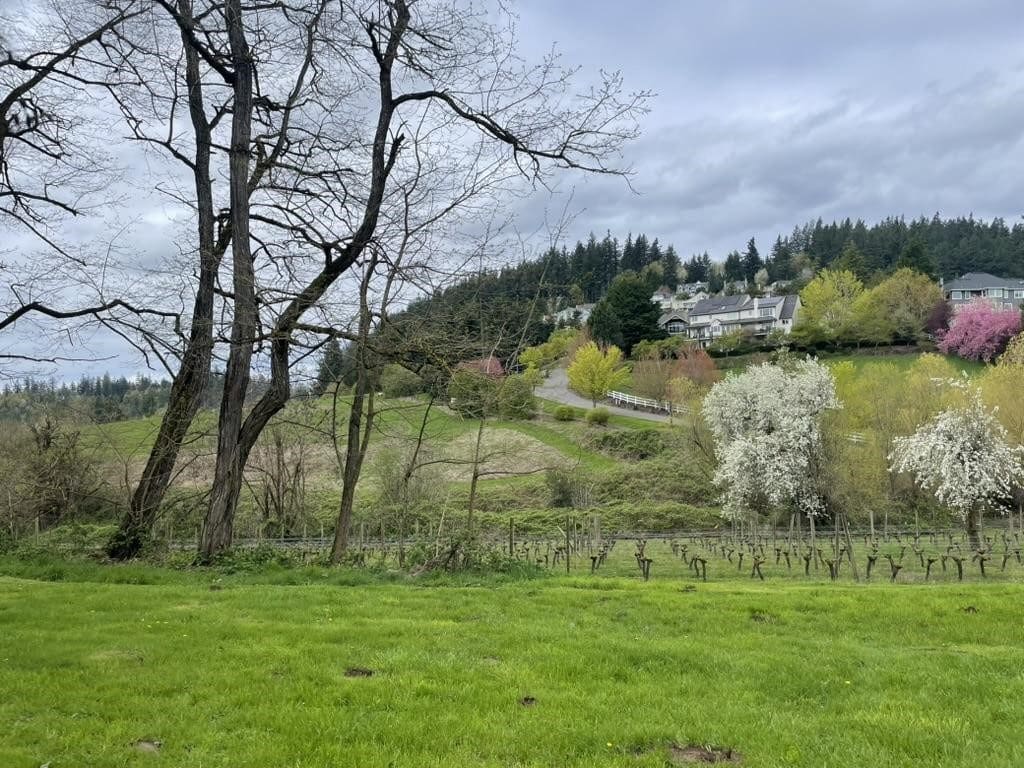The Oswego Lake Watershed Council (OLWC) is leading a project along Pecan Creek to restore streamside habitat for beavers, improve water quality, and give local students hands-on learning opportunities.
At the heart of this effort is a partnership with the Cook Farm, where students explore agriculture, land use, and natural resources. Historic beaver activity on the property has built dams that reshape waterways and influence the landscape, showing how powerful these ‘ecosystem engineers’ can be in creating healthy watersheds.
Restoration work focuses on removing invasive blackberry and replanting beaver friendly native species like willow, ninebark, spirea, and dogwood. As well as providing building materials and food for beavers, these plants help stabilize soil, filter stormwater, and provide a diverse habitat for fish and other wildlife.

Cook Farm, Pecan Creek, and Stevens Meadow view
Education is central to the project. Students from Lakeridge High School will:
- Take field trips to study streams, wetlands, and stormwater solutions
- Remove invasive species and plant native vegetation
- Grow native plants in their school greenhouse for use in restoration
- Learn from professionals about careers in ecology and sustainability
- Develop a long-term monitoring program
Beaver Facts
- Beavers are remarkable ecosystem engineers
Their dams create ponds and wetlands—“nature’s speed bumps”—that shape the flow and structure of waterways. - Wetlands stabilize and recharge water systems Beaver ponds help cool water, recharge groundwater, and diversify micro-habitats in stream channels.
- Dams slow water flow, reducing flood risk & erosion
By acting as natural flood regulators, beaver dams smooth out flow, allowing sediments and nutrients to settle and cutting erosion.

- Wetlands act like sponges—retaining water during droughts
These natural reservoirs slowly release water during dry periods, maintaining stream flows when they would otherwise fall. - Beaver wetlands help filter pollutants and clean water
As water slows in ponds, sediments, nitrogen, heavy metals, and even pathogens settle out—enhancing water quality. Some studies show reductions of E. coli and other pollutants by as much as 95%. - They create fire-resistant landscapes
Beaver-maintained wetlands retain moisture and act as fire breaks, slowing or stopping the spread of wildfires. - By engineering their surroundings, beavers enable lush, diverse vegetation
Their dam building floods terraces and stream banks, enabling riparian plants to thrive and, in turn, support robust insect, amphibian, bird, and mammal communities - Beaver activity supports wildlife and biodiversity
- Fish: Ponds offer ideal habitat and refuge for salmon, trout, and other species—boosting smolt productivity and survival.
- Amphibians: Deeper, longer-lasting ponds foster richer populations of frogs and salamanders.
- Birds & bats: Flooded structures create nesting, foraging, and refuge areas for waterfowl, songbirds, and even bats. Beavers’ coppiced willows and flooded trees increase bird species richness.
- Other wildlife: Turtles bask on lodges; rodents, otters, and more find shelter and feeding grounds.
Learn more about how beavers are restoring wetlands around Portland here.
Check out Project Beaver to learn more about ways to live with beavers in our community.
To learn more about how beavers help fight wildfires, check out this National Geographic article.
Want to get involved?
There are opportunities for neighbors and community members to volunteer with us on this project. Please contact Rio Hybert, Project Coordinator at rio@oswegowatershed.org
